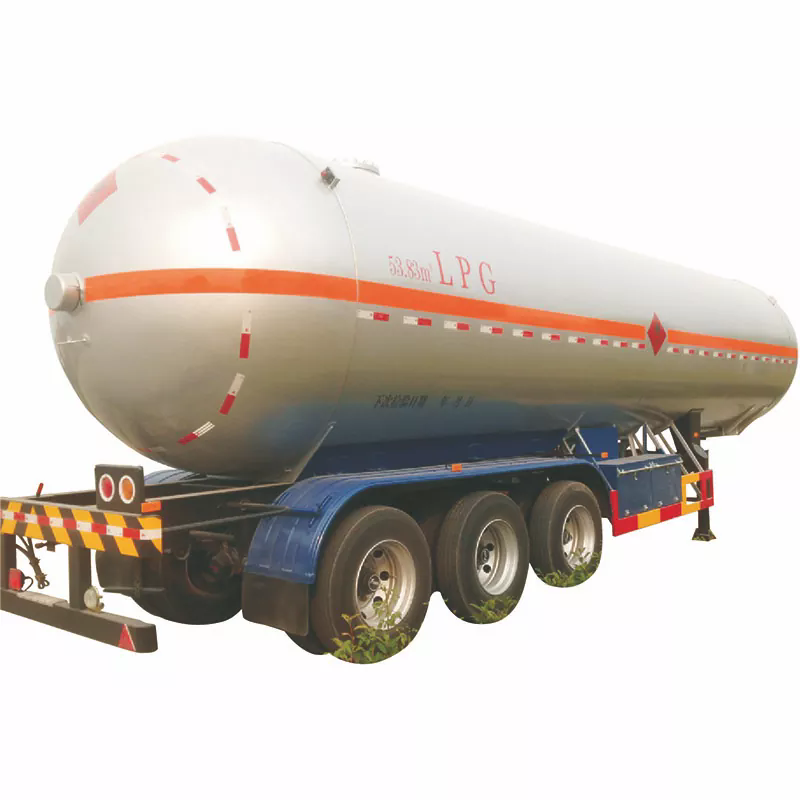Understanding LPG Tanker Semi-Trailers: Key Features and Applications
2024-08-14
LPG (Liquefied Petroleum Gas) is a crucial fuel source used in various industries, including residential heating, cooking, and as a fuel for vehicles. Transporting LPG safely and efficiently requires specialized equipment, and one of the most important tools in this regard is the LPG tanker semi-trailer. This blog will provide an in-depth look at LPG tanker semi-trailers, their key features, applications, and the safety considerations involved.
What is an LPG Tanker Semi-Trailer?
An LPG tanker semi-trailer is a type of specialized vehicle designed to transport liquefied petroleum gas in bulk. It consists of a tank mounted on a semi-trailer chassis, which is coupled to a prime mover or truck. The semi-trailer is designed to be towed by a truck, allowing for efficient transportation of LPG over long distances.
Key Features of LPG Tanker Semi-Trailers
1. Tank Construction:
The tank is typically made from high-strength steel or aluminum alloy, designed to withstand high pressure and corrosion. The material and construction are selected to ensure the safe storage and transportation of LPG.
2. Insulation and Heating:
LPG tanks often feature thermal insulation to maintain the gas in its liquid state and prevent temperature fluctuations. In some designs, heating systems are also included to manage the temperature of the LPG during transportation.
3. Pressure Control Systems:
To ensure safe operation, LPG tanker semi-trailers are equipped with pressure control systems, including pressure relief valves and safety devices. These systems manage the pressure within the tank to prevent over-pressurization and potential hazards.
4. Loading and Unloading Equipment:
The semi-trailer is fitted with loading and unloading equipment such as pumps, hoses, and valves. These components facilitate the transfer of LPG between the tank and storage facilities or distribution points.
5. Safety Features:
LPG tanker semi-trailers are equipped with a range of safety features, including fire extinguishers, emergency shut-off valves, and safety alarms. These features help mitigate risks and ensure compliance with safety regulations.
6. Regulatory Compliance:
The design and construction of LPG tanker semi-trailers adhere to strict regulations and standards set by industry bodies and government agencies. Compliance with these standards ensures the safe and efficient transport of LPG.
Applications of LPG Tanker Semi-Trailers
1. Bulk LPG Transportation:
LPG tanker semi-trailers are primarily used for bulk transportation of LPG from refineries or production facilities to distribution centers, storage tanks, and end-users. Their large capacity allows for efficient delivery of large quantities of LPG.
2. Distribution to Retail Outlets:
These semi-trailers play a critical role in the distribution network, delivering LPG to retail outlets, gas stations, and commercial facilities. They ensure that LPG is available for residential and industrial use.
3. Emergency Supply:
LPG tanker semi-trailers are also used in emergency situations to provide a quick supply of LPG to areas affected by natural disasters or other emergencies. Their mobility and capacity make them suitable for rapid response.
4. Industrial Applications:
In industrial settings, LPG tanker semi-trailers are used to transport LPG to facilities where it is used as a feedstock or fuel for industrial processes. They are essential for maintaining a steady supply of LPG to support production operations.
Safety Considerations
1. Handling and Transport:
LPG is a flammable and potentially hazardous substance, so handling and transportation require strict adherence to safety protocols. Operators must be trained in the proper handling of LPG and emergency response procedures.
2. Inspection and Maintenance:
Regular inspection and maintenance of the LPG tanker semi-trailer are crucial for ensuring its safe operation. This includes checking the integrity of the tank, pressure control systems, and loading/unloading equipment.
3. Regulatory Compliance:
Compliance with local and international regulations is essential for the safe transport of LPG. This includes adhering to standards for tank design, pressure testing, and safety equipment.
4. Emergency Preparedness:
Drivers and operators should be prepared for emergencies, including potential leaks, fires, or accidents. Proper emergency response plans and equipment should be in place to handle any incidents that may arise.
In Conclusion
LPG tanker semi-trailers are a vital component of the LPG supply chain, enabling the safe and efficient transportation of liquefied petroleum gas. Their specialized design, safety features, and compliance with regulatory standards ensure that LPG can be transported securely and reliably. Whether used for bulk transport, distribution, or emergency supply, these semi-trailers play a crucial role in delivering this essential fuel to where it is needed.
Understanding the key features and safety considerations of LPG tanker semi-trailers can help stakeholders in the LPG industry ensure that their operations run smoothly and safely. By adhering to best practices and regulatory requirements, they can contribute to the efficient and secure transport of LPG, supporting various applications and industries.



